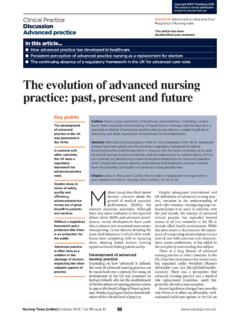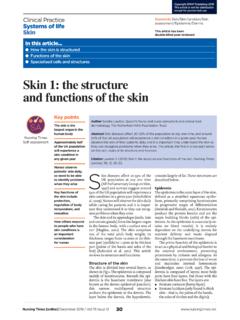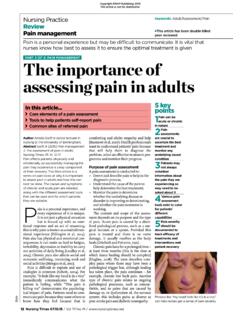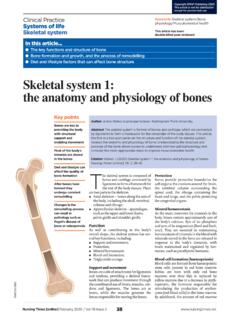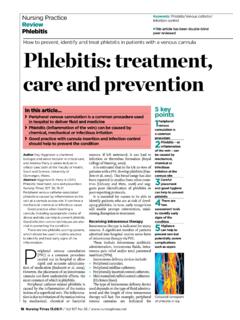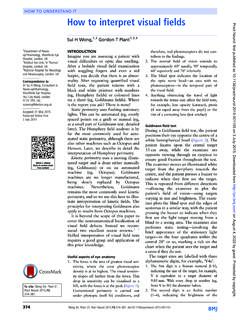Transcription of Urinalysis: how to interpret results - EMAP
1 1 Nursing Times / Vol 112 Online issue 2 / : Urine/Urology/Analysis/Reagent stick/Dipstick/Test This article has been double-blind peer reviewedAuthor Ann Yates is director of continence services, Cardiff and Vale University Health Yates A (2016) urinalysis : how to interpret results . Nursing Times; Online issue 2, an individual s urine can be a useful way of detecting or ruling out some diseases and infections. urinalysis can be undertaken in many ways, one of which is using a reagent stick. To be effective, the test must be performed properly and the results interpreted correctly.
2 This article gives an overview of the most important aspects of this investigation, highlighting signs to look for and what they may testing or urinalysis is a valuable tool to screen an patient and diagnose their health status. It provides valuable information about hydration, renal and urinary tracts, liver disease, diabetes mellitus and urinary-tract infections. Urine is formed in the kid-neys and, through glomerular filtration, tubular reabsorption and tubular secre-tion, is how the body gets rid of its natural waste products (Marieb and Hoehn, 2010).
3 urinalysis is easy to undertake but results must be interpreted of analysisThere are different ways of analysing urine and for different reasons, namely: 24-hour collection: patient voids into toilet, then all urine is collected for the next 24 hours. As the body chemistry alters constantly, this is used to measure substances, such as steroids, white cells, electrolytes or determine urine osmolarity (Tortora and Derrickson, 2009);5 key points 1 Urinary dipstick reagent strips are a quick, effective screening aid to urinalysis2 Nursing staff should understand the importance of examining urine for colour, clarity and odour before undertaking dipstick analysis 3 Urine can be collected in different ways to limit contamination4 Nursing staff should be able to carry out the procedure correctly and accurately interpret the results 5 Different components of the reagent strip have different clinical implications First-morning specimen.
4 First specimen of morning (or eight hours after recumbent position). Best sample for pregnancy testing; Fasting specimen: the second voided specimen after a period of fasting; Mid-stream urine (MSU): used to obtain urine for bacterial culture. First and last part of urine stream is voided into the toilet to avoid contaminating the specimen with organisms presenting on the skin; Random specimen: for chemical or microscopic examination, a randomly collected specimen suitable for most screening purposes; Catheter specimen of urine: collected for bacteriological examination if a patient s symptoms suggest the presence of a UTI.
5 The sampling technique used for collection is important (Baillie and Arrowsmith, 2005).This article focuses on random spec-imen and MSU samples, and analysis using dipstick reagent assessment/preparationUrinalysis can potentially identify the presence of life-changing conditions, such as diabetes and renal disease. If abnormali-ties are detected, the individual may need further investigations, so they should be appropriately counselled to understand the implications before providing a sample.
6 This has to be balanced against harm that could be caused by a missed diagnosis if urinalysis is not 50ml of urine is required for urinalysis . Adults and chil-dren who are continent and can empty their bladder should either provide a random sample or be advised to provide an In this Steps to follow when carrying out urine testing What to look out for Common causes of abnormalityUrinalysis is an important screening and diagnostic tool, but health professionals must know how to perform the test and interpret results correctly for it to be beneficialUrinalysis: how to interpret resultsNursing PracticeReviewUrologyFIG 1.
7 ColoUr / Vol 112 Online issue 2 / Nursing Times 2 Box 1. roUTiNe obServATioN of UriNeColour This usually ranges from pale straw to deep amber, depending on concentration (Steggall, 2007). Dark urine: may indicate dehydration Brown/green or strong yellow: may indicate presence of bilirubin Green: may indicate presence of pseudomonas infection or excretion of cytotoxic drugs, such as mitomycin Bright red/red-brown: may indicate presence of blood (haematuria). Menstruation should be ruled out in femalesCertain food or drugs may also influence colour; beetroot can produce a pinkish shade and rifampicin can turn urine This is usually referred to as clear, slightly cloudy, cloudy or that can cause cloudiness but are not harmful include mucus, sperm, prostatic fluid and skin cells.
8 Other substances that make urine cloudy are white/red blood cells, pus or bacteria that need attention. Frothy urine signifies protein in the Freshly voided urine may have a slight but inoffensive smell. Fishy smell/ammonia: may indicate urinary infection Pear drop or acetone smell: may indicate presence of ketones, as in diabetic ketoacidosis Some strongly flavoured foods can also produce an odour, eg asparagusIt can also indicate a blood-clotting dis-order or be a side-effect of anticoagulant drugs.
9 Health professionals should also remember that urine can be contaminated with menstrual blood. Goddard et al (2010) highlighted that in most patients investi-gated for haematuria, no real presence of an underlying cause could be found and the haematuria was put down to a benign cause. However, as serious conditions cannot be identified unless investigated, it is important that haematuria is appropri-ately investigated unless a sensible reason, such as menstruation, can be and urobilinogenBilirubin is a chemical produced when red blood cells are broken down.
10 It is trans-ported in the blood to the liver, where it is processed and excreted into the gut as a constituent of bile. In the gut, bacteria acts on the bilirubin to transform it into uro-biligen. It is usual for urine to contain uro-biligen but not bilirubin. Bilirubin in the urine may be an indicator of a breakdown of red blood cells. It may not be effectively removed by the liver, which may suggest liver disease or a problem with drainage of bile into the gut, such as gall are not usually found in urine and are associated with the presence of bacteria strip.
